

The company produced motorcycles between 1899 and 1940.
Victorian era.
1897 Formerly known as Hotchkiss, Mayo and Meek at Hill Cross Works, Coventry; when Hotchkiss died and John Meek left the company, it came under the control of Edmund Mayo and Bernard Rotherham and moved to Lincoln Street, named as the Coventry Eagle Cycle Co.
Production began with the building of bicycles and then tricycles assembled from bought-in parts. These cycles were well-built and popular, which strongly contributed to the ongoing success of the firm.
Edwardian era.[1]
The earliest range had included a model with an MMC engine hung from the downtube and by this time it had increased to a range of singles in loop frames, with sprung forks and belt final-drive. In an attempt to add a passenger, the solo could tow a trailer. It was probably most unpleasant, as there would have been fumes and road dirt flung up from the machine itself. It was quite likely that the tow-bar would eventually have snapped. There was also a forecar and later a sidecar, and engines from De Dion and Buchet were employed. During this period they also produced machines under the Royal Eagle name.
In 1900 they were listed at Lincoln Street, Coventry, maker of Motor Cycles. The following year the original company was liquidated and reformed as the New Coventry Eagle Co, with Edmund Mayo's son Arthur Edmund Mayo joining the company as secretary.
Report from the 1902 Stanley Show
Motor Cycling, 26th November 1902
In 1912 they were listed in Spennell's directory of Coventry as Cycle Manufacturers, and at that time they also made Eagle cars.
1914 The range now included three models. The smallest was lightweight and powered by a 269cc Villiers engine driving a two-speed gearbox by chain and belt final-drive and with Druid forks. It was also available as a single-speed machine The other two models used Abingdon engines as a 3½ h.p. single and a 5 to 6 h.p. V-twin, with three speeds and belt final-drive.
1916 There was also a model with a 2.5hp JAP engine.
Post-World War I. Only singles were produced.
1921 The company returned to V-twins for this year only. There were two sidecar models that had either a 500cc single or a 680cc V-twin JAP engine.
1922 The company produced only singles, once again, using engines from Villiers, JAP and Abingdon King Dick.
1923 Six models were in the catalogue - the JAP V-twin returned, together with the appearance of the famous sporting twin Flying Eight. In various forms, this sporting twin would become one of the best remembered motorcycles. Additionally, there was a 147cc two-stroke of their own design and a Blackburne 350.
1924 The two-stroke engine was enlarged to 170cc and the Flying Eight was available with sv or ohv JAP engines. With the latter and a Jardine gearbox, it became the second most expensive machine on the market.
1925 The two-stroke engine was enlarged again - to an Aza 175cc, with an Albion two-speed gearbox.
Two-strokes were then dropped altogether for a couple of seasons as the company concentrated on a wide range of four-strokes in single, twins and sidecar combinations.
1928 The policy of four-stroke only came to an end with the arrival of twin-port, super-sport Villiers engines in 147cc, 172cc and 172cc twin-port, super-sports forms appeared in a set of pressed steel cycle parts. The company also began to use forks from pressed sheet steel. Although this was common in Europe, Coventry Eagle were the first major British company to use this method - a move that proved to be very successful for the following decade.
1929 There were minor frame changes and the arrival of 196cc Villiers and 197c JAP engines brought the range to five models. The Flying Eights continued to progress and a similar name style was used on models with 344cc and 490cc two-port ohv JAP engines, known as the Flying 350 and the Flying 500. Both had a new cradle frame and tubular Webb girder forks.
1930 Most of the range continued and new models were added using dry-sump Sturmey-Archer inclined engines of 348cc and 495cc in conventional tubular frames.
1931 Twins were dropped and only the production of two-strokes continued for some years. Many of the models were stylish and distinctive with large exhaust systems, as on the Silent Superb. The most basic was the 98cc Marvel. Other model names were Wonder and Eclipse, most in a pressed steel frame.
1932 saw the a new version of the Silent Superb. The Eclipse and Wonder models continued along with two 550cc JAP and Sturmey-Archer machines, and 350 and 500cc OHV singles. 1932 Range
1935 The next sensation was the Pullman, with a new type of pressed-steel frame with enclosure of the mechanics and rear wheel. The rear suspension was controlled by leaf springs running along the frame sides.
1937 The four-stroke singles returned, using Matchless engines in three sizes. These, plus a variety of two-strokes, from an autocycle to the Pullman, ran on to the end of the decade.
1940 Production, drastically cut because of the war, soon ceased and never resumed .
Notes. 1.
Sources: Graces Guide, The Motor Cycle